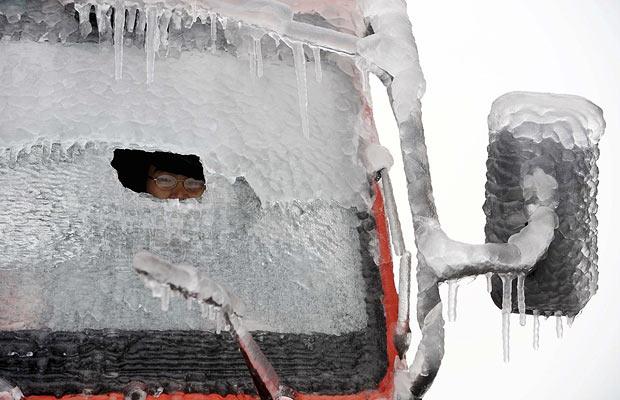A single-vehicle accident is any driving mishap involving only one vehicle. This can include veering off the road and hitting a tree, a rollover crash, or damage caused by animals or debris on the road. Bad weather, poor visibility, and distracted driving can all be contributing factors, so drivers must remain alert when they take the wheel. Advances in technology can be both positive and negative when discussing distracted driving.
Now is a good time to remind your drivers of the following tips:
Prepare for your trip before you turn the key.
Many things can slow you down en route to your destination, so it’s wise to spend some thoughtful preparation time to help ensure safe travels.
Check the weather report.
If you cross county or state lines, you may experience changes in weather patterns. Be prepared to handle rain, snow, or other conditions that may affect your ability to drive.
Start safely.
Familiarize yourself with the vehicle’s controls and adjust any settings as needed, including seat position, mirrors, and the steering wheel. Always keep your seat belt fastened while driving.
Allow more time to travel.
This will reduce your urge to speed if you’re slowed by unpredictable circumstances.
Turn your headlights on.
Not only does this enhance your vision, but it also helps others see you.
Stay focused to avoid distractions.
Distracted driving can impair your ability to react quickly. Stay focused on the road, including what’s in front of you and in your mirrors.
Prepare for anticipated distractions.
This includes things like money for a toll booth, mealtimes, or the need to reach for sunglasses. Avoid eating, drinking, or smoking while driving whenever possible.
Monitor your surroundings.
As you drive, be mindful of lane changes, traffic signs and signals, curves, road work, and pedestrians. Spotting a situation early gives you more time to react, if necessary.
Turn off your cell phone.
Operating a CMV with a non-hands-free cell phone is a federal violation. Even a phone sitting on the passenger seat can be a distraction as it emits sounds and vibrations that distract the driver’s attention.
Approximately five seconds is the average time your eyes are off the road while texting. When traveling at 55 mph, that’s like driving the length of a football field blindfolded.
Take a break.
If you’re feeling drowsy or have a task that cannot wait, pull over to a safe spot out of the way of traffic.
Monitor conditions to reduce the risk of losing control.
A safe driver constantly monitors road conditions and is ready to adjust. Knowing how to handle your vehicle in a variety of situations reduces the risk of being involved in an accident.
Note how road materials affect traction.
Asphalt can be more slippery than concrete or gravel due to its petroleum content, especially when wet from rain or snow.
Be especially careful on sharp curves and steep inclines.
These conditions make vehicle handling more difficult. Also, be wary of the dangers posed by soft shoulders and potholes.
Slow down.
Driving above the posted speed limits increases the likelihood of losing control, makes it harder to recover, and reduces critical reaction time.
Beware of standing water and wet leaves.
Maintaining moderate speeds is especially important in these conditions, as it helps avoid the need for sudden braking and skidding.
And… get plenty of sleep.
Are you driving with "Tunnel Vision" this winter?
Tunnel vision occurs when a driver clears only a small area of ice and/or snow from their vehicle's windshield, creating just enough space to see through a tiny hole while driving. This practice significantly reduces a driver’s field of vision and greatly increases the risk of a collision. The Kansas Highway Patrol estimates that drivers who do not fully clear their windshields of ice, snow, and fog limit their field of vision to only about 2 to 3 percent of what a driver with a clear windshield can see.
A recent survey conducted by the Center for Safe Driving found that more than 50 percent of drivers admitted to not fully clearing snow or ice from the windows of their vehicles. As a countermeasure, many states have enacted laws requiring drivers to make reasonable efforts to remove snow or ice from their vehicles. Additionally, numerous law enforcement agencies across the country are planning to target drivers who fail to clear their windshields this winter.
As part of your pre-trip inspection, you should ensure that the windshield, side windows, and
mirrors are clear of any snow, ice, or fog before starting your route or trip. Another dangerous situation involves chunks of snow or ice flying off the top of your vehicle and landing on vehicles behind you. These chunks can be quite heavy and turn into dangerous projectiles that can cause crashes, injuries, or even fatalities.
If heavy snow is forecasted, it is recommended that you pull your unit away from the dock or terminal building to prevent a drift of snow from accumulating on the roof of the building and transferring to the top of your trailer or truck. As a professional driver, it is important to recognize this unsafe behavior in other drivers and be prepared to avoid a collision by staying out of their way.
I am using a driver leasing company, who is responsible for the compliance with the Federal Motor Carrier regulations?
Answer: Driver services and driver leasing companies are not motor carriers and are not responsible for compliance with the regulations. The driver service or leasing company may complete activities such as driver qualification files, annual reviews, road tests, etc. at the direction of the motor carrier. However, keep in mind that you the motor carrier are responsible for any non-compliance with the FMCSA regulations.










